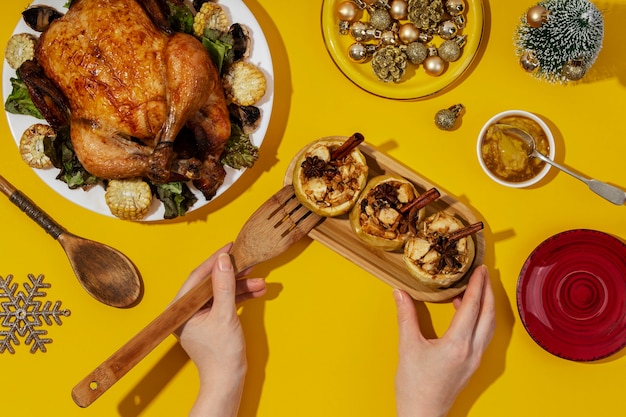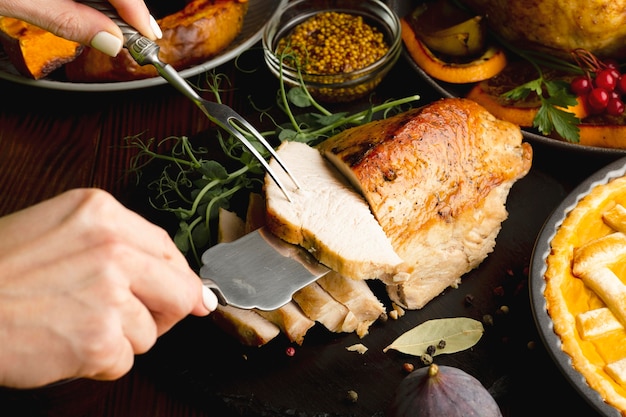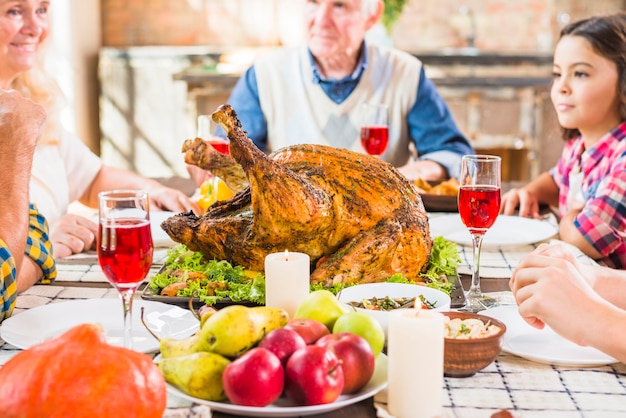Ah, the humble turkey. A culinary cornerstone of festive gatherings, but often a source of anxiety for even the most seasoned cooks. Especially when it comes to a hefty 14-pounder. I've been there, folks, faced with the daunting task of cooking this magnificent bird to perfection. But fret not, I’m here to guide you through the journey, sharing my hard-earned wisdom and personal experiences along the way. We'll tackle the cooking time, the preparation, the roasting process, the carving, and everything in between. Let’s get this Thanksgiving (or Christmas) bird roasted to perfection, shall we?
(Part 1) The Big Picture: turkey cooking Time

First things first, let's get a handle on the big picture: how long does it actually take to cook a 14-pound turkey? The answer, my friends, is not a simple one. It depends on a whole bunch of factors, and understanding those factors is key to a perfectly cooked bird.
Factors Affecting Cooking Time
Think of cooking time as a delicate dance between various elements. Here are the key players:
- Oven Temperature: The higher the temperature, the faster the turkey cooks. A standard roasting temperature is 325°F, but you can bump it up to 350°F for a slightly quicker cook.
- Turkey Size and Shape: Two 14-pound turkeys might look identical, but one could be wider or thicker than the other, affecting cooking time. A wider turkey takes longer to cook through, as the heat needs to travel further to reach the center.
- Stuffing: Ah, stuffing! A delightful addition, but it also requires time to cook through, adding to the overall roasting time.
- Oven Type: Every oven has its quirks. Some ovens run hotter or colder than others, affecting the cooking time.
So, while a general estimate for a 14-pound turkey is 3-4 hours, it's crucial to remember that this is just a guideline. You'll need to monitor the bird closely and use a meat thermometer to ensure it's cooked through.
(Part 2) The Countdown Begins: Getting Ready to Roast

Alright, now that we've got a grasp on the cooking time, let's get this turkey ready for its star turn. Remember, proper preparation is key to a succulent and delicious bird.
The Big Prep: Thawing and Brining
First things first: thawing. If you've got a frozen turkey, it's essential to thaw it thoroughly in the refrigerator. It's all about patience and planning. A 14-pound turkey can take up to 3-4 days to thaw completely in the fridge. Never, ever thaw a turkey at room temperature or in a warm bath. This can lead to bacteria growth, which can make you sick.
Now, let's talk about brining. It's a bit of a culinary debate, but I'm a firm believer in the magic of brining. It involves soaking the turkey in a salty solution, which adds moisture and flavor, resulting in a juicier, more flavorful bird. You can find countless brining recipes online, but my go-to is a simple mixture of salt, sugar, herbs, and water.
If you're short on time, don't stress. You can still achieve a delicious turkey without brining. But, let me tell you, a brined turkey is a game-changer. The flavor is simply divine, and the tenderness is incredible.
The Fine Tuning: Patting Dry and Trussing
Once your turkey is thawed (and brined, if you've chosen to go that route), the next step is to pat it dry with paper towels. A dry turkey skin is crucial for achieving that golden-brown, crispy skin that we all crave. Trust me, crispy skin is the best part.
Now, let's talk trussing. It's a simple but effective technique that involves tying the turkey's legs and wings together. This helps to keep the bird compact, preventing the legs from drying out and ensuring a more even cook.
The Flavor Factor: Seasoning and Stuffing
Alright, now we're getting to the fun part: flavor! Get ready to spice up that turkey with a delightful rub of butter, olive oil, salt, pepper, and your favorite herbs and spices. My personal favorites? Thyme, rosemary, and garlic. You can't go wrong with a classic combination.
And if you're stuffing your turkey, now's the time to fill that cavity with your favorite stuffing recipe. Remember, though, stuffing takes a bit longer to cook through than the turkey itself, so make sure it's cooked properly.
One more crucial tip: before you start stuffing, remember to remove the giblets from inside the turkey. Those little packets of organs are best left for other culinary creations.
(Part 3) Into the Oven: The Baking Process

It's finally time to shine a spotlight on the star of the show: the turkey. It's prepped, seasoned, and ready to take center stage in the oven.
Finding the Sweet Spot: Oven Temperature and Placement
As we mentioned earlier, a standard oven temperature for roasting a turkey is 325°F. But if you're in a hurry, you can crank it up to 350°F. Ultimately, it comes down to personal preference and time constraints.
Now, let's talk placement. Position the turkey in the middle rack of your oven to ensure it cooks evenly on all sides. If you're using a roasting pan, make sure it's big enough to accommodate the turkey without overcrowding it.
Here's a little trick that will help keep your turkey moist and flavorful: add about a cup of water to the bottom of the roasting pan. The steam created will help prevent the turkey from drying out.
Keeping an Eye on the Timer: Cooking Time and Temperature
Alright, the clock is ticking. Now comes the crucial part: determining the cooking time and monitoring the temperature.
The Golden Rule: 14 Pound Turkey Cooking Time
A 14-pound turkey will typically take around 3-4 hours to roast. However, this is just a starting point. You’ll need to check the internal temperature to ensure it's cooked through.
The Temperature Test: Using a Meat Thermometer
A meat thermometer is your best friend when it comes to roasting a turkey. It’s an essential tool that takes the guesswork out of the equation. Insert the thermometer into the thickest part of the thigh, making sure it's not touching any bone. The turkey is fully cooked when it reaches an internal temperature of 165°F.
The Finishing Touch: Basting and Resting
As your turkey roasts, give it a few bastings to keep it moist and flavorful. You can use the pan juices or a simple butter and herb mixture. And remember to check the temperature every hour or so.
Once the turkey reaches the desired internal temperature, take it out of the oven and let it rest for at least 30 minutes before carving. This resting period allows the juices to redistribute throughout the meat, resulting in a much juicier turkey.
(Part 4) The Feast Begins: Carving and Serving
Ah, the grand finale! The turkey is cooked, rested, and ready for its star turn at the dinner table. It's time to carve and serve this culinary masterpiece.
The Carving: Getting the Most Out of the Bird
carving a turkey isn't rocket science, but it does require a bit of finesse. Start by removing the legs and thighs. Then, slice the breast into thin pieces, working from the outside in. Use a sharp knife, and don't be afraid to ask for help if you need it.
The Presentation: Putting on a Show
Now that your turkey is carved, it's time to showcase this culinary triumph. Arrange the turkey and sides on a beautiful platter, and don't forget to add some festive touches, like sprigs of rosemary or cranberries. You want to create a visually appealing centerpiece for your table.
(Part 5) Leftovers: Not to Be Wasted
So, you’ve had your turkey feast, and you're left with a mountain of delicious leftovers. Don't let them go to waste! There are countless ways to transform those leftovers into delightful meals.
The Sandwich Classic: Leftover turkey sandwiches
Turkey sandwiches are a timeless classic for a reason. They're quick, easy, and incredibly satisfying. Simply pile some leftover turkey on a slice of bread, add some cheese, lettuce, tomato, and your favorite condiments.
The Comforting Option: turkey soup
When the weather turns chilly, a warm bowl of turkey soup is the perfect comfort food. You can use leftover turkey, broth, vegetables, and noodles to create a hearty and satisfying soup.
The Creative Touch: turkey pot pie
For a more elaborate leftover turkey dish, try making a turkey pot pie. It's a delicious and satisfying meal that's perfect for a chilly night. Simply layer leftover turkey, vegetables, and gravy in a pie crust, bake, and enjoy.
(Part 6) Turkey Cooking Time Chart
To help you navigate the cooking time for different sizes of turkeys, here's a handy chart that provides a general guideline.
| turkey weight (pounds) | Cooking Time (hours) | Internal Temperature (°F) |
|---|---|---|
| 10-12 | 2 1/2 - 3 | 165 |
| 12-14 | 3 - 3 1/2 | 165 |
| 14-16 | 3 1/2 - 4 | 165 |
| 16-18 | 4 - 4 1/2 | 165 |
| 18-20 | 4 1/2 - 5 | 165 |
Remember, these are just guidelines. Always check the internal temperature of your turkey to ensure it's cooked through.
(Part 7) The Art of Turkey: My Personal Experiences
cooking a turkey is more than just following a recipe. It's an experience. It's about the anticipation, the laughter, the tantalizing aromas, and the sense of accomplishment. Over the years, I've had some memorable turkey-related moments, both triumphs and hilarious mishaps.
The First Time: A Learning Curve
My first turkey was a bit of a disaster. I was a novice then, and I ended up with a dry, overcooked bird. But, you know what? It was a valuable lesson. It taught me the importance of careful monitoring and the power of a meat thermometer.
The Triumphant Moment: A Perfectly Roasted Bird
I’ll never forget the time I cooked a turkey for my family, and it turned out absolutely perfect. The skin was crispy, the meat was juicy, and everyone raved about it. It was a moment of pure culinary pride.
The Unexpected Twist: The Time I Forgot the Stuffing
Yes, you read that right. I've been there. I was so focused on the turkey itself that I completely forgot about the stuffing. It was a close call, but I managed to throw together a quick stuffing in the last minute.
(Part 8) The FAQs: Your Turkey Questions Answered
Let's address those burning turkey questions that keep popping up.
Q: How do I know if my turkey is cooked through?
A: The best way to know is to use a meat thermometer. Insert it into the thickest part of the thigh, making sure it doesn't touch any bone. It should register 165°F for a fully cooked turkey.
Q: What do I do if my turkey is still frozen?
A: It's best to thaw a turkey in the refrigerator. A 14-pound turkey will take about 3-4 days to thaw completely. Never thaw a turkey at room temperature or in a warm bath, as this can lead to bacteria growth.
Q: Can I stuff my turkey the night before?
A: It's not recommended to stuff your turkey the night before. This can lead to bacteria growth, which can make you sick. It's best to stuff the turkey right before you put it in the oven.
Q: How long can I store leftover turkey in the fridge?
A: You can store leftover turkey in the refrigerator for up to 3-4 days. Be sure to refrigerate it in an airtight container or wrap it tightly in plastic wrap or aluminum foil.
Q: How do I reheat leftover turkey?
A: You can reheat leftover turkey in the oven, microwave, or on the stovetop. When reheating in the oven, be sure to heat it to an internal temperature of 165°F.
So, there you have it, my friends. A comprehensive guide to cooking a 14-pound turkey. Remember, don’t be afraid to experiment and find what works best for you. And most importantly, have fun!
Everyone is watching

How to Cook Frozen Lobster Tails Perfectly: A Step-by-Step Guide
RecipesLobster. Just the word conjures up images of lavish meals, special occasions, and a taste of luxury. But let's...

Pigs in a Blanket Cooking Time: How Long to Bake for Perfect Results
RecipesAh, pigs in a blanket. Just the name conjures up images of those delightful little parcels of crispy pastry en...

Pork Fillet Cooking Time: How Long to Cook It Perfectly
RecipesPork fillet, or tenderloin as it's sometimes called, is a real favourite in our house. It's so versatile, and...

The Ultimate Guide to Cooking Delicious Frankfurters
RecipesLet's face it, we all love a good frankfurter. It's a classic, simple, and always satisfying. But let's be rea...

The Ultimate Guide to Tender, Juicy Pulled Pork
RecipesRight, let's talk pulled pork. It's one of those dishes that just screams "comfort food," doesn't it? I mean...
